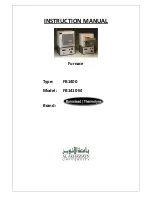
PMP-098
Oil Furnaces
–
Furnace Manual
11/13
7
1.8.
COMBUSTION AIR SUPPLY AND
VENTILATION
Poisonous carbon monoxide gas hazard.
Comply with NFPA 31 (U.S.) and CSA B139 (Canada)
standards for the installation of Oil Burning
Equipment and applicable provisions of local building
codes to provide combustion and ventilation air.
Failure to provide adequate combustion and
ventilation air can result in death, bodily injury and/or
property damage.
Oil furnaces must have an adequate supply of combustion air. It is
common practice to assume that older homes have sufficient
infiltration to accommodate the combustion air requirement for the
furnace. However, home improvements such as new windows,
doors, and weather stripping have drastically reduced the volume of
air infiltration into the home.
Refer to oil furnace installation codes relative to combustion and
ventilation air requirements. Consult Section 1.3 in this manual,
specifically for units installed in an enclosed space.
Home air exhausters are common. Bathroom and kitchen fans,
power vented clothes dryers and water heaters all tend to create a
negative pressure condition in the home. Should this occur the
chimney becomes less and less effective and can easily downdraft.
In certain cases, mechanically supplied air, by way of a blower,
interlocked with the unit, is necessary. It is the installer’s
responsibility to check that.
1.8.1.
Contaminated Combustion Air
Installations in certain areas or types of structures will increase the
exposure to chemicals or halogens that may harm the furnace.
These conditions will require that only outside air be used for
combustion.
The following areas or types of structures may contain or be
exposed to certain substances, potentially requiring outside air for
combustion:
a. Commercial
buildings;
b.
Buildings with indoor pools;
c.
Furnaces installed near chemical storage areas.
Exposure to the following substances:
a.
Permanent wave chemicals for hair;
b.
Chlorinated waxes and cleaners;
c.
Chlorine based swimming pool chemicals;
d. Water
softening
chemicals;
e.
De-icing salts or chemicals;
f. Carbon
tetrachloride;
g.
Halogen type refrigerants;
h.
Cleaning solvents (such as perchloroethylene);
i.
Printing inks, paint removers, varnishes, etc. ;
j. Hydrochloric
acid;
k.
Solvent based glue;
l.
Antistatic fabric softeners for clothes dryers;
m. Acid based masonry cleaning materials.
1.8.2.
Burner with Outdoor Combustion
Air Kit
Some burners are designed to function with combustion air taken
directly from the outside. Follow the instructions provided with the
burner, the fresh-air supply kit or the side-wall venting kit.
1.9.
OIL TANK
Fire and
explosion hazard.
Use only approved heating type oil in this furnace.
DO NOT USE waste oil, used motor oil, gasoline or
kerosene.
Use of these will result in death, bodily injury
and/or property damage.
When a 0.75 USGPH or smaller nozzle is used, a 10
micron or finer filter, must be installed on the oil
supply line to the furnace inside the building where
the unit is located.
This is a requirement in order for the heat
exchanger warranty to remain in force.
Check your local codes for the installation of the oil tank and
accessories.
At the beginning of each heating season or once a year, check the
complete oil distribution system for leaks.
Ensure that the tank is full of clean oil. Use No.1 or No.2 Heating Oil
(ASTM D396 U.S.) or in Canada, use No.1 or No.2 Furnace Oil.
A manual shut-off valve and an oil filter shall be installed in
sequence from tank to burner. Be sure that the oil line is clean
before connecting to the burner. The oil line should be protected to
eliminate any possible damage. Installations where the oil tank is
below the burner level must employ a two-pipe fuel supply system
with an appropriate fuel pump. A rise of 2.4 m (8') and more requires
a two stage pump and a rise greater than 4.9 m (16') an auxiliary
pump. Follow the pump instructions to determine the size of pipe
needed in relation to the rise or to the horizontal distance.
1.10.
CONNECT SUPPLY AND RETURN
DUCTS
1.10.1.
Duct sizing
1.10.1.1.
Determine airflow CFM
The temperature rise through the furnace must not exceed 85
o
F, but
should be at least 55°F for comfort. When calculating airflow,
assume a temperature rise of 70°F.
The noticeable temperature change for cooling would be
approximately 27 - 30°F. Actual temperature change will be
approximately 18 - 21°F due to humidity of the air.
To calculate noticeable heat temperature change (
Δ
T), you can use
the formula:
Δ
T = BTU/h / (1.1 x CFM)
Eq. 3 - 1
To calculate air flow when you know temperature change (
Δ
T), you
can use:
CFM = BTU/h / (1.1 x
Δ
T)
Eq. 3 - 2
You can estimate air flow using the following rules of thumb:
Heating:
14 CFM per 1,000 BTU/h
output
Eq. 3 - 3
Cooling:
400 CFM per ton
air conditioning
Eq. 3 - 4
Determine the required airflow based on whichever is larger: heating
mode or air conditioning mode.
Examples:
1.
What would the temperature rise be for a 100,000 BTU/h output
furnace with an airflow rate of 1200 CFM?
Use Equation 3 - 1 since you know CFM and BTU/h:
Δ
T = 100,000 / (1.1 x 1200) = 76°F
•
The temperature rise would be 76°F.
•
If the air enters the furnace at 70°F, it would leave the
furnace at 70°F + 76°F = 146°F.


































